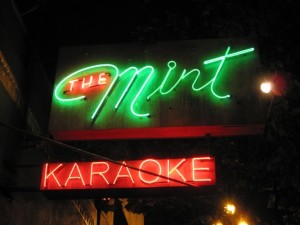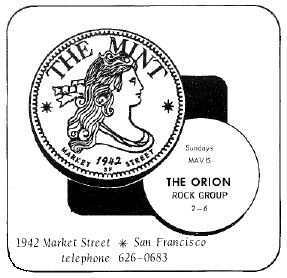 1942 Market Street
1942 Market Street
San Francisco, California 94114
(415) 626-4726
TheMint.net
Status: LGBT Bar
In Their Own Words: The Mint Karaoke Lounge, a San Francisco institution — and once a steakhouse and a piano bar — continued its evolution to karaoke in 1993. Since then, The Mint has grown to become one of the world’s best known karaoke lounges. Vistors worldwide often come to the Mint straight from the airport, and hotel concierges advise their guests that for karaoke there is no other. It is the favorite haunt of many friendly locals who make a point of dropping by a few times a week. Open 365 days a year, karaoke hours are from 3:00 PM T0 2:00 AM Sunday through Saturday.
History
Summary
| Name | Dates of Operation |
| The Mint | 1968 – present |
Details
 In 1968, longtime lesbian bar owner Charlotte Coleman opened The Mint with Peggy Forster, who later went on to buy the Twin Peaks Tavern with MaryEllen Cunha. The bar is on Market Street in the shadow of the new U.S. Mint above Safeway.
In 1968, longtime lesbian bar owner Charlotte Coleman opened The Mint with Peggy Forster, who later went on to buy the Twin Peaks Tavern with MaryEllen Cunha. The bar is on Market Street in the shadow of the new U.S. Mint above Safeway.
If we consider The Mint to be within the boundaries of the Castro area, it holds the record for being the longest continuously operated gay bar in the neighborhood to operate with the same name.
Coleman and Forster owned a number of other gay and lesbian bars in the neighborhood: “The Mint, The Trap, The Blue and Gold, Gilmore’s up at the cable car turnaround, Sharp’s Bar and Restaurant and a bar down in San Carlos. They also owned the Golden Cask on Haight Street,” according to Cunha (quoted in the Article 10 Landmark Historic Preservation Commission Case Report).
Lesbian pioneer Del Martin, who founded the Daughters of Bilitis with her partner (and later wife), Phyllis Lyon, said that at the Golden Cask, Coleman required lesbians to wear skirts at first because the gay male customers expected it – and, according to Martin, the money was with the gay men because lesbians didn’t go out as much. When she opened the Mint, Coleman had the same skirts dress code for female patrons. Most gay bars expected it; only in North Beach bars were lesbians allowed to wear pants because they were considered to part of the bar’s “floor show,” providing local flavor for tourists.
Although Rikki Streicher, another lesbian bar owner, perceived the Daughters of Bilitis to be anti-bar, Martin said it was based on a misunderstanding because there were references in the DOB’s newsletter, The Ladder, that proclaimed the DOB as an alternative to the bar scene. Bars could be dangerous. Bars got raided by the police at a time when same-sex behavior was illegal, when patrons could get arrested and lose their jobs and their families if their names were publicized. But the DOB weren’t anti-alcohol or even anti-bar; they patronized the Golden Cask and followed Coleman to the Mint because Coleman was so supportive of the DOB and provided alcohol for their functions.
Lyon and Martin encouraged Coleman to open a lesbian bar, and she said she would do it – if they provided the funding. She didn’t think it would work because not enough lesbians went out. As a result, the Mint, like Twin Peaks and many other lesbian-owned bars, was intended for a mixed male/female crowd rather than strictly for lesbians.
In 1972, Coleman started an event called The Great Tricycle race in which participants would race on tricycles from bar to bar in drag to help raise funds for charitable causes. The event included a major stop at the newly-gay Twin Peaks owned by Coleman’s friends Ellen Cunha and Peggy Foster, and always ended at the Mint. The tradition continued for 21 years, and was revived in 2007 by the Sisters of Perpetual Indulgence.
In 1973, The Mint sponsored one of the inaugural teams of a gay softball league that was founded that year, a league that started in San Francisco and now includes about 60 cities nationwide.
Following Harvey Milk’s assassination in 1978, Coleman began a campaign to erect a bust of Harvey Milk in City Hall. She deposited funds won at one of the Tavern Guild’s blackjack parties into a bank account which was then forgotten when AIDS hit the City a few years later, devastating the gay community. In 2003, then-Supervisor Matt Gonzalez revived the plan and in 2007, Coleman read about the campaign and remembered about the long-forgotten bank account. The money had been turned over to the state’s lost property accounts. With interest, it had grown to nearly $9,000.
Originally a steakhouse and piano bar, The Mint evolved into a karaoke bar in 1993. It is routinely named Best Karaoke Bar by the Bay Guardian, the Bay Area Reporter, and other publications.
Sources
Article 10 Landmark Historic Preservation Commission Case Report, Initiation of Designation: Twin Peaks Tavern, San Francisco Planning Department, September 12, 2012.
Bajko, Matthew S., “Online extra: Political Notes: Story generates $15,000 for Milk bust group,” Bay Area Reporter, May 15, 2008.
“Best of the Bay 2012 Readers Poll: Arts and Entertainment,” San Francisco Bay Guardian, July 24, 2012.
“Best of the Gays, Part 1,” Bay Area Reporter, April 7, 2011.
Boyd, Nan Alamilla, Wide Open Town, University of California Press, 2003.
Brigham, Roger, “In the beginning, there was Jack,” Bay Area Reporter, November 13, 2008.
Flanagan, Michael, “Old is New: Twin Peaks celebrates historic status,” Bay Area Reporter, January 2, 2014.
The Mint website, accessed August 16, 2014.
Sweetlips, “Hallowinners,” Bay Area Reporter, October 25, 2007.
Location
1942 Market Street, San Francisco
DOes anyone know what happened to cabaret singer Gloria Stockton who used to sing on Sundays at the Old Mint?